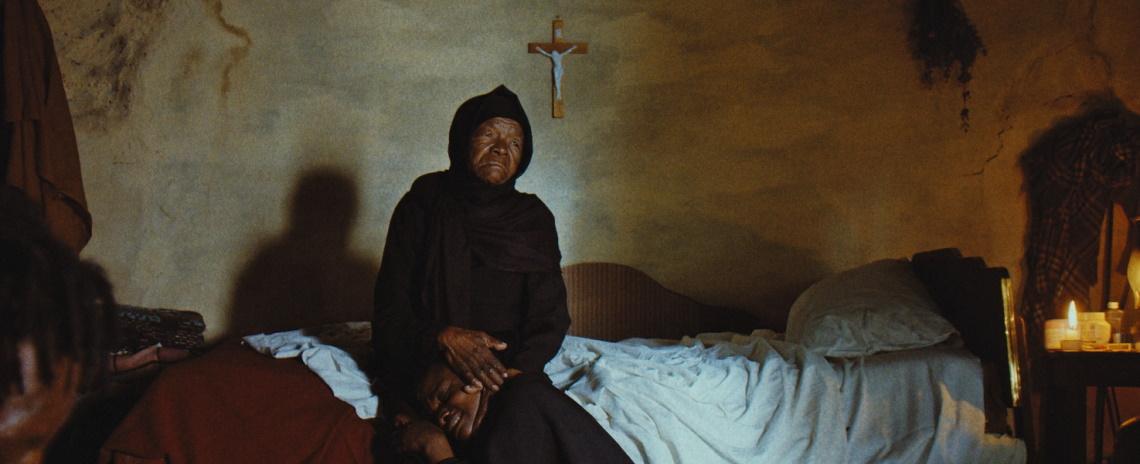Mantoa’s son is dead. And those people up there on the cliff are marking where the dam will go. They’re almost not even people. All sealed up in their yellow worker suits, they look like aliens, and they sort of are. They don’t belong here, and they’re the reason she’s been told she must leave. She must leave the land on which she’s always lived because that dam will cover the entire valley with water, including the waste-ridden graveyard containing the remains of her family, their ancestors, and her freshly buried son. This is all before the fire – one that claims her hut and ignites her quest to be as dead and buried as her child.
She’s just standing there watching them, but Mantoa has gotten so old her eyelids are cliffs she has to work to hold up in order to do so. Especially against her prominent cheekbones, the Mosotho woman’s mouth has also become so sunken into her face that it’s difficult to discern her expression. She’s either standing there slack-jawed in awe or teeth-clenched from incredulous anger that her home has been overridden by the worker bees up on that cliff.
Mary Twala, the actor playing her might be familiar: She’s a prominent figure of a very different recent Africa-set film, Beyoncé’s Black Is King (2020). She has since passed, but her presence here stings so hard, she continues to vibrate in the body as if she’s left some of herself behind.
Director Lemohang Jeremiah Mosese’s square frame – antiqued by presenting itself fully, rounded corners and all – shows her character’s point of view. The audience has been trained to believe so: The film cuts away from her looking at the surveyors to a shot of them. The lens is gradually pulling back away from those figures in front of a small range of peaks. Presented on a flat horizon line, it appears that they’re at the bottom of the range in front of a plain filled with desert flowers made so yellow by the rich film stock used that the sights are nearly blinding. What else would one use to capture the eye-popping majesty of the South Africa-locked country of Lesotho?
More of the landscape continues to fill the frame, and Yu Miyashita tightens the director’s screws with a clanging, vertiginous score. The topography of the land is becoming difficult to parse, but what’s been revealed suggests the camera could be facing down a hill. It’s all still sharply in focus – the hills, the people, the flowers, the rocks – as Mantoa emerges at the bottom of the frame walking toward the camera on flat earth. The eye and brain have been fooled. The only point of view the shot represents is that of the lens, and the shape of the land is not as initially seemed to be. The shot isn’t a magic trick, though, since it has purpose beyond the reveal. The ambiguity of ownership, personhood, and self-possession contained within the one-take marvel also drives everything that surrounds it.
That lens is also the viewpoint of Mosese, who, in pulling such feats throughout, will be compared to the likes of Antonioni, Tarkovsky, and Herzog. On one hand, it’s true. This is Not a Burial, It’s a Resurrection is a mesmeric behemoth of people in their terrains. On the other, it’s a pronouncement of a fiercely maverick vision that deflects comparison.
Mosese surely has seen and digested the works of the aforementioned filmmakers, but Resurrection is also deeply personal, taking cues from his family’s past and culture rather than a cinematic past. Its form also more closely resonates as a shared fable – one painfully birthed from a womb lined with love for the land and anger at its colonization. Although the poetry within contains a narrative, the discrete stanzas swing wildly from mood to mood and mode to mode. This is Not a Burial, It’s a Resurrection is a mess of raw emotions that possessed its maker. Stacked against more traditional cinema– even those at the artiest of arthouses – its effects are almost physically jarring. New visions of the world always seem so, and this is the opposite of a burial: It’s a revolution.
Rating: A-
This Is Not a Burial, It's a Resurrection is now available to rent via virtual cinemas from Dekanalog. Purchase a ticket between April 2 - 15 and the proceeds will help support the Webster University Film Series.


